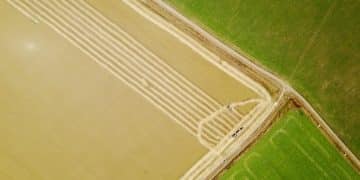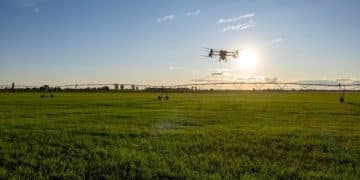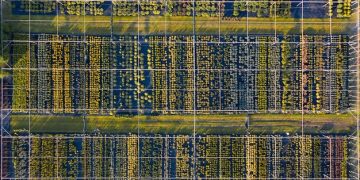Precision Agriculture: US Market Growth Drivers & Trends to 2025
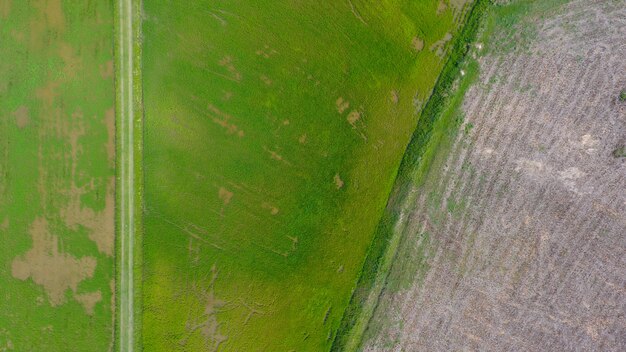
The projected 12% growth in US precision agriculture by 2025 is primarily driven by technological advancements, increasing demand for sustainable farming practices, and supportive government policies that incentivize adoption.
The US precision agriculture market is poised for significant expansion, with a projected 12% growth rate by 2025. But what’s driving the projected 12% growth in US precision agriculture by 2025? This article explores the key trends and factors fueling this surge, offering insights into how technology and sustainability are reshaping American farming.
Understanding the Precision Agriculture Landscape
Precision agriculture, often referred to as smart farming, involves using technologies like GPS, sensors, and data analytics to optimize crop yields and reduce waste. The US market is rapidly adopting these methods to enhance efficiency and sustainability.
Several factors contribute to the growth of precision agriculture. These include the need for increased food production to feed a growing global population, the drive for more sustainable and environmentally friendly farming practices, and the availability of advanced technological solutions.
Key Technologies in Precision Agriculture
Various technologies are at the forefront of this agricultural revolution. These innovations help farmers make data-driven decisions and improve operational efficiency.
- GPS and GIS Systems: Providing accurate location data for mapping and navigation, ensuring precise application of resources.
- Sensors and IoT: Gathering real-time data on soil conditions, weather patterns, and crop health, enabling informed decision-making.
- Data Analytics and AI: Processing vast amounts of data to identify patterns, predict outcomes, and optimize farming practices.
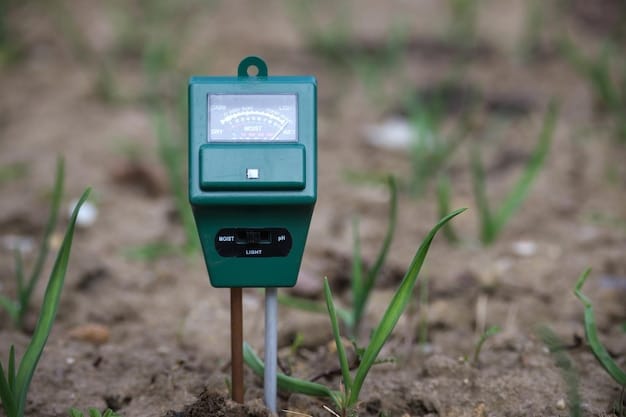
These technologies work together to provide farmers with a comprehensive understanding of their operations, enabling them to make the most of their resources and reduce their environmental impact.
The Role of Technological Advancements
One of the primary drivers of growth in precision agriculture is the continuous advancement of technology. New and improved tools are constantly being developed to address the challenges faced by farmers.
From more accurate sensors to sophisticated data analytics platforms, technology is making it easier for farmers to optimize their operations and improve yields. Here’s a closer look at some key areas of technological development.
Improved Sensor Technology
Advancements in sensor technology allow for more precise monitoring of various environmental factors. These sensors can measure soil moisture, nutrient levels, and even detect plant diseases early on.
By providing real-time data, these sensors enable farmers to make timely adjustments to irrigation, fertilization, and pest control strategies, leading to more efficient use of resources.
Data Analytics and AI
Data analytics and artificial intelligence (AI) play a crucial role in processing the vast amounts of data generated by precision agriculture technologies. These tools help farmers identify patterns, predict outcomes, and make informed decisions.
- Predictive Modeling: Using historical data to forecast crop yields, identify potential problems, and optimize planting schedules.
- Automated Decision-Making: Implementing AI algorithms to automatically adjust irrigation and fertilization based on real-time data.
- Precision Spraying: Utilizing AI-powered drones to identify and target specific areas with pests or diseases, reducing the overall use of pesticides.
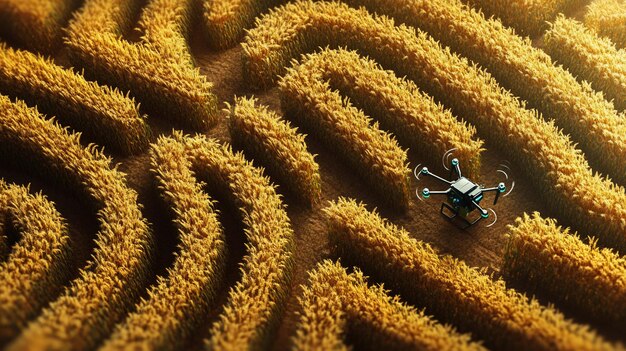
These advancements are empowering farmers to make data-driven decisions that can significantly improve their bottom line and reduce their environmental impact.
The Push for Sustainable Farming Practices
Sustainability is becoming an increasingly important consideration in agriculture. Consumers, governments, and farmers themselves are recognizing the need to adopt practices that protect the environment and ensure long-term viability.
Precision agriculture offers a range of tools and techniques that can help farmers achieve their sustainability goals. Here are some of the key benefits of adopting precision agriculture practices.
Reduced Water Consumption
Precision irrigation techniques, such as variable rate irrigation (VRI), allow farmers to apply water only where and when it is needed. This can significantly reduce water consumption and prevent waterlogging.
By using soil moisture sensors and weather data, farmers can fine-tune their irrigation schedules to ensure that plants receive the optimal amount of water, minimizing waste and conserving valuable resources.
Optimized Fertilizer Use
Precision agriculture enables farmers to apply fertilizers more efficiently, reducing the risk of nutrient runoff and minimizing environmental pollution. By using sensors and data analytics, farmers can determine the exact nutrient needs of their crops.
- Variable Rate Fertilization: Applying different amounts of fertilizer to different areas of the field based on soil conditions and crop requirements.
- Nutrient Monitoring: Regularly testing soil samples to track nutrient levels and adjust fertilization strategies accordingly.
- Precision Placement: Using GPS-guided equipment to apply fertilizers directly to the root zone, minimizing waste and maximizing uptake.
These practices not only reduce environmental impact but also lower input costs for farmers, making them more economically sustainable.
Government Policies and Incentives
Government policies and incentives play a crucial role in driving the adoption of precision agriculture practices. Many countries, including the US, offer financial assistance, tax breaks, and other incentives to encourage farmers to invest in these technologies.
These policies are designed to promote sustainable agriculture, improve food security, and boost the agricultural economy. Here are some of the key government initiatives supporting precision agriculture in the US.
USDA Programs
The United States Department of Agriculture (USDA) offers a variety of programs to support the adoption of precision agriculture practices. These programs provide funding for research, education, and technical assistance.
One of the key USDA initiatives is the Environmental Quality Incentives Program (EQIP), which provides financial assistance to farmers who implement conservation practices, including precision agriculture techniques.
Tax Incentives
Some states offer tax incentives to farmers who invest in precision agriculture technologies. These incentives can help offset the initial costs of adopting these technologies, making them more accessible to a wider range of farmers.
- Equipment Tax Credits: Providing tax credits for the purchase of precision agriculture equipment, such as GPS-guided tractors and sensor systems.
- Research and Development Grants: Offering grants to support research and development efforts aimed at improving precision agriculture technologies.
- Property Tax Reductions: Reducing property taxes for farmers who implement sustainable farming practices, including precision agriculture techniques.
These supportive policies are helping to create a favorable environment for the growth of precision agriculture in the US.
Challenges and Opportunities
While the outlook for precision agriculture is bright, there are still some challenges that need to be addressed. Overcoming these hurdles will be essential to fully realizing the potential of these technologies.
Here are some of the key challenges and opportunities facing the precision agriculture market.
Initial Investment Costs
One of the biggest barriers to adoption is the initial cost of investing in precision agriculture technologies. These technologies can be expensive, particularly for small and medium-sized farms.
However, as the cost of these technologies continues to decline and as more government incentives become available, they are becoming more accessible to a wider range of farmers.
Data Management and Security
Precision agriculture generates vast amounts of data, and managing and securing this data can be a challenge. Farmers need to have the tools and expertise to effectively analyze and protect their data.
- Data Storage Solutions: Implementing cloud-based data storage solutions to securely store and manage agricultural data.
- Cybersecurity Measures: Employing robust cybersecurity measures to protect against data breaches and cyberattacks.
- Data Privacy Policies: Establishing clear data privacy policies to ensure that farmer data is protected and used responsibly.
Skills Gap
Another challenge is the skills gap in the agricultural workforce. Farmers need to have the knowledge and skills to effectively use and maintain precision agriculture technologies.
Future Trends in Precision Agriculture
Looking ahead, the precision agriculture market is expected to continue to evolve and grow. Several emerging trends are poised to shape the future of farming.
Here are some of the key trends to watch in the coming years.
Increased Automation
Automation will play an increasingly important role in precision agriculture, with robots and drones taking on more tasks that are currently performed by humans. This will help farmers reduce labor costs and improve efficiency.
From automated planting and harvesting to autonomous weed control, automation is transforming the way crops are grown and managed.
Integration of IoT and AI
The integration of the Internet of Things (IoT) and artificial intelligence (AI) will enable even more sophisticated and data-driven farming practices. Farmers will be able to use real-time data to make more informed decisions and optimize their operations.
- Smart Irrigation Systems: Using AI to automatically adjust irrigation schedules based on weather patterns and soil conditions.
- Precision Pest Control: Implementing AI-powered drones to identify and target specific areas with pests, reducing the overall use of pesticides.
- Crop Monitoring: Deploying IoT sensors to continuously monitor crop health and detect potential problems early on.
Focus on Regenerative Agriculture
There will be a growing focus on regenerative agriculture practices, which aim to improve soil health, increase biodiversity, and sequester carbon. Precision agriculture technologies can play a key role in helping farmers implement these practices.
| Key Aspect | Brief Description |
|---|---|
| 🌱 Tech Advancements | Improved sensors and AI boost efficiency. |
| 🌍 Sustainability | Reducing water & fertilizer use for eco-friendly farming. |
| 💰 Govt Support | Policies and incentives drive precision ag adoption. |
| 🤖 Automation | Robots & AI enhance decision-making & efficiency. |
Frequently Asked Questions
▼
Precision agriculture involves using technology to optimize crop yields and reduce waste. It uses data-driven decision-making to improve efficiency and sustainability in farming practices.
▼
Key benefits include increased crop yields, reduced water consumption, optimized fertilizer use, and minimized environmental impact. It also leads to more sustainable and cost-effective farming.
▼
Technology provides tools like GPS, sensors, and data analytics. These tools help farmers monitor conditions, predict outcomes, and automate processes for better decision-making.
▼
Government policies offer financial assistance and tax incentives. These programs encourage farmers to invest in precision agriculture technologies and promote sustainable practices.
▼
Future trends include increased automation with robots and drones, integration of IoT and AI for data-driven insights, and a focus on regenerative agriculture for long-term sustainability.
Conclusion
The projected growth in US precision agriculture by 2025 is driven by technological advancements, sustainability efforts, and supportive government policies. By embracing these trends, farmers can improve their yields, reduce their environmental impact, and ensure a more sustainable future for agriculture.
